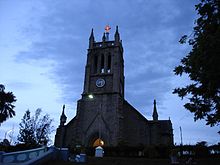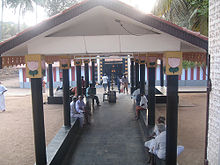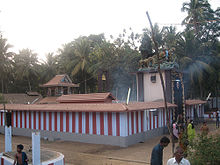- Martandam
-
Martandam — town — Coordinates Country India State Tamil Nadu Time zone IST (UTC+05:30) Martandam is the second largest town in the Kanyakumari district of Tamil Nadu, India, at the border with Kerala. It is also a major trade centre across National Highway (NH 47). Originally called "Thoduvetty", it was a portion of Kanyakumari district which was added to the state of Tamil Nadu on November 1, 1956. Martandam is strategically located. It is one of the most fertile lands of Tamil Nadu and has the climatic conditions of Kerala. It has a railway line connecting the capital of Kerala, Trivandrum, with the southernmost tip of India, Kanyakumari. The station is still called Kuzhithura. Martandam is well connected to Madras by train and bus services. Martandam may have gotten its name from the ruler of Travancore, Marthanda Varma.[citation needed]
Martandam is famous for honey, cashew nut processing, rubber and hand-embroidered motifs. The area is full of greenery, and there is a river adjoining. It is also a major trade center due to its location bordering the state of Kerala, in southern India.
Martandam is home to the Nesamony Memorial Christian College, Government Higher Secondary School (in existence for close to 150 years) and the Victory Embroidery School. The latter provides work to women skilled in the art of hand embroidery from the surrounding villages. Mr. S. Retna Raj, the founder of Victory Embroidery School in 1950, was the first industrialist of Martandam who brought this market town in the textile map of Tamil Nadu(Source The Dinamalar Daily 8-9-2003 Page.6). Martandam is also home to the renowned 'Christuraja Matriculation School' run by the Daughters of Mary convent.
Martandam has to its pride an old church built exclusively of stone by a British architect, John Sinclair. There is a Lord Ayyappa temple in Martandam at the banks of Kuzhithura River. This temple is known as either "Vettuvenni temple" or "Vedisasthan Kovil". The latter name is due to the fire cracker being burst at the temple as a mark of prayer to Lord Ayyappa. This temple is just by the side of National Highway NH-47 connecting Trivandrum with Nagercoil. The main festivals celebrated here are Christmas and Onam.
Food and culture
Martandam is known for its cuisine which is typically of Southern Travancore in nature. The people of Martandam, irrespective of their caste consume fish at least twice a day.
Saalna, this ethnic version of stew has more than just mutton in it. It is a testimony to the colonial impact on the community, whose fortunes improved in the 19th century. Sigappi kozhi serppu, Sattampillai meen kozhambu, cauliflower kothu idiappam and vengaya serppu Manohari or sautéed potato mash, and vendakkai mayakkal that truly live up to their names along with Seeranis and jaggery based sweets.
Folk Arts
There are several Folk Arts practiced in temples for Sastha (ayyanar), Sudalaimadan and Isakkiamman. Villupattu is especially for Sastha temples and Kaniankoothu is practiced for Sudalaimadan. Grand Tamil poetess Avvaiyar temples are found along with Isakki amman temples and worship of teachings of Avvaiyar can be observed
Many Folk arts and dances are popular in this district. They are played during the time of festivals in temples, celebrations in schools etc. Bow Song (Villu Paatu) is an ancient form of musical- storytelling art of southern Tamil Nadu. Villu Paatu has been especially popular in Thovalai and neighbouring areas of the district.
Bow, the age-old weapon of warriors - paradoxically lends itself to be used as a primary musical instrument for the Villu Pattu artists. There are Udukku , Kudam, Thala, Kattai, etc. as supplementary instruments in their performances. Udukku, mentioned in the ancient Tamil literature as Thudi, is a small drum with a slender middle portion which is held in the left hand and played by the fingers of the right hand. Occasionally, the Villu Pattu team divides itself into two groups, each trying to prove opposite points-of-view of a subject. This is called Lavani Pattu. The songs used by the Villu Pattu artists are mostly traditional folk-songs.
Thiruvathirai Kali occupies the pride of place among the folk dances. It resembles Kummi and is played especially during Onam festival. The players are young girls. The necessary number of girls is 8,10,12 or 16 for each dance. They move round and sing in chorus. Each girl strikes the stick (Kole) which she holds in each hand, and the striking of the sticks and the steps , which she makes are rhythmical to the tune.
Kalial is a folk dance played by group of men or boys in the country side. A group leader sings songs and keeps time with cymbals. The players stand in a circle with sticks in their hand and dance round a lighted lamp repeating the songs sung by the leader. They turn, twist, lean forward and backward, squat and move round singing to the tune. At the beginning the steps are elaborate and at times, they are also very quick. When invited to perform in a function, the players generally begin the dance with an invocation for heavenly aid and conclude the dance with a torch - dance using lighted torches. This folk dance exhibits the artistic and recreative life of the country side.
Kathakali is a unique form of drama, which has its origin in Travancore. Kathakali (story-dance) is a relatively recent (fifteenth or sixteenth century) development of earlier dances, which, like dances every where, arose out of religious expression through symbolical action. In this art-form, the characters express their ideas not by words, but by significant gestures. In Kanyakumari District, it is now played in the temples at Thiruvattar, Thirparappu, Ponmana, Kuzhithura, Neyyoor and Munchira during the time of festivals.
Ottam Thullal is a form of story telling. It is a popular for of amusement, staged in the temple premises and Malayalam is the language commonly used. Ottam Thullal is now played in the temples of Thiruvattar, Thirparappu, Ponmana and Thirunanthikara in the district during the time of festivals.
Kalari, is an ancient martial art of Kerala. A tradition believed to have been founded by Parasurama is known as Vadakkan Kalari ; another is credited to Agasthiar in which the emphasis is on striking at vital points of the body and not on weapons, even through sword, knife, Urumi (rolling sword), Mankombu (horns of a deer), Kandakkodali, (a kind of axe), mazhu (a kind of axe) etc., are also used. Kanyakumari district is home to an indigenous form of martial arts called 'Adimurai' or 'naadan', which is often confused with the Kalari of Kerala, in spite of its uniqueness.
Categories:- Cities and towns in Kanyakumari district
Wikimedia Foundation. 2010.



